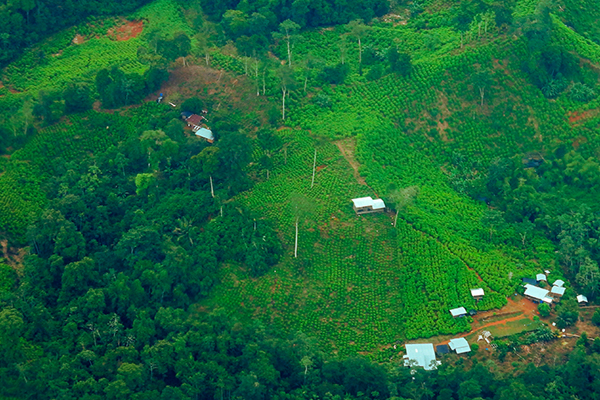On June 25, a report by the US Office of National Drug Control Policy was released, which noted that potential cocaine production in Bolivia, Colombia and Peru had peaked in the past 10 years. Such conclusions have already prompted various assessments in Latin American countries. What data does the US Office provide? How will this report affect the image of regional governments?
Last Friday’s Washington report, “The Office of National Drug Control Policy Releases Data on Coca Growth and Potential Cocaine Production in the Andean Region”, examines the results of the White House’s annual assessments that take into account coca cultivation and potential cocaine production in Colombia, Peru and Bolivia. Potential production of cocaine refers to the sowing of illicit coca crops for the production of coca paste (base), as well as the process of refining and obtaining cocaine hydrochloride, that is, a refined drug. Each time in this document, two variables are analyzed. The first concerns the total plantings of coca leaves, and the second concerns the potential for cocaine production.
It is worth looking at the main findings of this year’s report. According to the report of the Office of National Drug Control Policy (ONDCP), in the period from 2010 to 2020 potential cocaine production in Bolivia increased by 44%. Meanwhile, according to a document published on June 25, 2019 to 2020 coca plantings in Bolivia decreased by 7%. In turn, Colombia and Peru saw record increases in coca leaf production. In the case of Colombia – by 15% last year, and in Peru – the highest rate in the last 10 years: an increase in acreage at the level of 88.2 thousand hectares.

Bolivia’s ruling party denies the facts of this report are accurate. Andres Flores and Freddy Velazquez, deputies from the “Movement to Socialism” party (ingles – Movimiento al Socialismo, MAS), who are originated in the Yungas region where coca is grown, rejected the US Office report and confirmed that Bolivia has demonstrated since 2006, that with the help of “nationalization” of the fight against drugs, a more effective counteraction to drug trafficking is being carried out in the country.
Velazquez questioned this document. “I don’t know where they get these numbers, because in the case of Bolivia, and since we nationalized the fight against drug trafficking through the EU (European Union) and the UNODC (United Nations Office on Drugs and Crime), we found big “lacerations” of the past, when the United States Agency for International Development (USAID) had a presence in the country. According to the deputy, the Bolivian government will apply control to the fullest extent of the law against drug trafficking. His colleague Andres Flores was also skeptical about the report. “They say that the production of cocaine has increased, I think that this is not the case, we are not promoting the production of cocaine”, concluded a representative of the lower house of the Bolivian Plurinational Legislative Assembly.
According to the report, in 2020 the area under coca sowing in Bolivia amounted to 39.4 thousand hectares, which is 7% less than in 2019 (42.18 thousand hectares), but is still close to a record level. The corresponding production potential for cocaine remained constant at 312 metric tons. Likewise, according to tables published by the US Office of Drug Control Policy, there will be 301 tons of potential cocaine production in 2019. Over the year, the amount increased by 11 tons. A year earlier, in 2018, 251 tons of potential cocaine production were recorded. In 2010, this range was 216 potential cocaine per year.
In the case of Colombia, the coca crop reached its highest level in a decade. In 2020, the area planted for this crop grew by almost 15% compared to 2019.The report also says that the Colombian government reported a record 130 thousand hectares of land destroyed by hand, and almost 580 metric tons of cocaine and coca paste (base) seized in 2020.
Following the release of this report, the Colombian government said it faced a number of obstacles during this time that have affected overall efforts to curtail coca cultivation, including increased rural violence and high rates of Covid-19. Colombia’s coca cultivation and cocaine production reached a record 245 thousand hectares and 1,010 metric tons, respectively, last year, according to estimates by the US Office of Drug Control Policy. According to Washington, such trends show the need to strengthen holistic approaches that combine economic development, greater government presence and citizen security, banning and eradicating coca cultivation in key rural areas in order to sustainably reduce cocaine production and establish a truce in conflict-affected areas.

As for Peru, the US Office of National Drug Control Policy marks a historic record for the cultivation of coca in 2020 – 88.2 thousand hectares. Over the past five years, this figure has doubled, since in 2016 the level of illegal plantations was set at 44 thousand hectares.
Representatives of this Office in their document drew attention to the fact that in Peru the health crisis has largely become an obstacle to the initiatives of the government of the Latin American country aimed at eradicating the problem. “The pandemic has created significant obstacles to the Peruvian government’s efforts to provide alternative livelihoods to former coca growers, build transportation infrastructure in underdeveloped areas and keep Peruvian villagers safe”, the report said.
The US Office of National Drug Control Policy report has already generated varying assessments in the region and beyond. To be sure, Latin America continues to be one of the world’s top drug-producing regions. This affects politics, economics and other aspects of life in the countries of the region. Drug trafficking in Latin American states meets the needs of both domestic and foreign markets. Historically, the White House has fought this “tsunami” from Latin America through tools such as the United States Agency for International Development and the United States Drug Enforcement Administration (DEA).
The regional panorama has changed in recent years. For example, in 2008, the government of Evo Morales (Juan Evo Morales Ayma) suspended the work of the US Agency for International Development and expelled representatives of the DEA, who, according to the Bolivian authorities, interfered in internal affairs and threatened the national sovereignty of Bolivia. Today, many years later, Washington’s reports are often not ignored by local governments, and Latin American states submit their anti-drug reports annually. In this delicate issue, the main topics remain: achieving a balance in the choice of strategy and means, as well as the reliability of the facts. As at the beginning of the 21st century, these fundamental problems have not been resolved.


